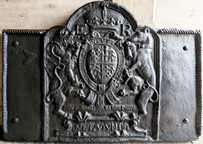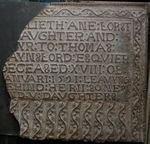-
995
Description: Arched; fillet edging; English royal Stuart shield, garter, crown, supporters, 'CS' monogram to left of Garter buckle, and motto on a cartouche; small rose stamp repeated each side of crown; date split each side of top of crown (first part absent in this casting).
Notes: Although English arms, the design is in a continental style, arched firebacks being typical of Lorraine; the 'CS' monogram is likely to be that of the pattern-maker; a modern copy of a poor casting, hence the incomplete date. For the complete version see no. 994.
Copies of this fireback are known.
Inscription: [16 missing] 21 / HONI SOIT QVI MAL Y PENSE / CS / DIEV ET MON DROIT
Arms: English Stuart royal (James I)
- Decoration tags:
- rounded arched (shape)
- cavetto (edging)
- whole carved pattern
- planklines
- monogram
- armorial
- royal
- text
Manufactured: in 1621 in England.
Current location: not known.
- Attached to series:
- Jacobean royal armorial firebacks
- Stuart royal armorial firebacks
-
157
Description: Arched rectangular shaped central panel with paternost bead edging; figure holding a bow in his left hand and a lyre in his right hand, a quiver suspended from his belt, on an undulating ground with small trees, and suspended swags of drapery above; Arched rectangular shaped border with fillet edging, and symmetrical flowers and swirled tendrils; initials at bottom centre; on top, symmetrical pattern of swirled leaves and tendrils.
Notes: The figure is Apollo, personifying the Sun, one of a set of 'Eight Deities' engraved by Hendrick Goltzius (1592), after Polidoro da Caravaggio; the fireback is one of a large group bearing the same initials, which probably denotes the pattern maker. Other groups may have been the work of the same carver or workshop. The execution is rather crude. Formerly part of the J. H. Every collection.
Copies of this fireback are known.
Inscription: SHR
- Decoration tags:
- 'Dutch' (shape)
- fillet (edging)
- whole carved pattern
- planklines
- mythological
- monogram
- text
Manufactured: in the late-17th to early-18th century in England.
Current location: Anne of Cleves House, Southover High Street, Lewes, East Sussex, England.
Museum number: 1944.24.73 (part of the Sussex Archaeological Society museum group)
- Attached to series:
- SHR series
- British 'Dutch' style firebacks
- Eight Deities series
-
914
Description: Rectangular shape; twisted rope edging (top and sides) with fillet edging at bottom; cast of a 1598 fireback within a recessed panel, the arch of the original fireback being overlaid with twisted rope and diagonal lengths of rope laid alongside. The original fireback is described as follows: Composite of three elements; central panel has a complex ‘knot’ pattern with a fillet edge; side panel, repeated on either side of the central panel, contains a vase of flowers, possibly stylised thistles, within an arched frame and fillet edge; arched panel above, also with fillet edge, contains the date and inscription; the spandrels of the side panels, and the arched top panel, contain a series of 'bullseye' motifs comprising concentric rings deepening towards the centre.
Notes: The central fireback measures 795mm wide by 735mm high and is from a different casting to that seen at Linchmere, Sussex (no. 475).
Inscription: 1598 / IM IB
- Decoration tags:
- rectangular (shape)
- rope (edging)
- composite
- planklines
- text
- plants
- objects
Manufactured: in the late-16th to early-17th century in the Weald area of England.
Current location: Goddards, Abinger Common, Abinger, Surrey, England.
- Attached to series:
- Armada series
- Composite firebacks
- Garden design types
-
1122
Description: Plain rectangular plate with cyma reversa, or ogee, moulding on top and sides.
Notes: A base board without other decoration. Other firebacks may have been cast using it.
- Decoration tags:
- rectangular (shape)
- cyma reversa/ogee (edging)
- carved pattern panels
Manufactured: in the 17th century in England.
Current location: 10 Garden Street, Accrington, Lancashire, England.
- Attached to series:
- Base boards
-
10
Description: Rectangular; rope edging (top and sides); central Tudor royal shield with encircling garter (motto reversed: HONE SOVT QVEY … PEN), separate greyhound and lion supporters, separate crown; a bird, repeated in each top corner, its wings displayed and inverted and its head facing behind and to the left, standing on a scroll; a fleur de lys repeated in the bottom corners; inside the birds is a repeated stamp, half of one similar to a stamp on a fireback in Hastings Museum.
Notes: The particular form of the Tudor arms and supporters is encountered on other firebacks, as are the distinctive style of fleurs de lys and the birds (probably swans, a Lancastrian icon). The plain scroll upon which the bird is perched suggests that there might have been a painted inscription on it originally and that the stamp had not been made specifically for the decoration of firebacks but was, perhaps, redundant from interior domestic decoration. Formerly at Framfield, East Sussex.
Arms: Tudor royal (prob. Henry VIII)
- Decoration tags:
- rectangular (shape)
- rope (edging)
- carved stamps
- heraldic
- armorial
- royal
- objects
Manufactured: in the early- to mid-16th century possibly at Pounsley Furnace, Framfield in the Weald area of England.
Current location: The Clergy House, Alfriston, East Sussex, England.
Museum number: 200044 (part of the National Trust museum group)
-
1128
Description: Quasi-arched shape with forward-facing 'wings', which splay outwards towards the base; the 'wings' curve to follow the shape of the main panel but curl outwards at the top; central panel with pictorial image of, to the right, a shepherd holding a musical pipe, his right foot upon a log, upon which a dog, to the left, sits holding the shepherd's crook; top centre, a crown, on either side of which, on the curled upper parts of the 'wings', is an inward facing sheep.
Notes: Nothing is known about the sources of free-standing firebacks or what prompted their production. Their form is similar but the predominant use of horticultural or arboreal decorative themes, which suggests production within a limited time frame, has in this instance been replaced with a humorous scene. Only a very small number of such castings are known. Depth 210mm
- Decoration tags:
- free-standing (shape)
- none (edging)
- whole carved pattern
- heraldic
- pictorial
- animals
- humans
- plants
- objects
Manufactured: in the late-17th to early-18th century in England.
Current location: not known.
- Attached to series:
- Free-standing firebacks
-
1133
Description: Arched rectangular central panel with bead on fillet edging; flowers in a gadrooned vase upon a pedestal; arched rectangular border with fillet edging containing flowers descending from a ribbon bow; at the bottom, date; on top, symmetrical swirled foliage.
Notes: The swirled foliage on top and the proportions of the fireback suggest an English origin.
Inscription: 1723
- Decoration tags:
- whole carved pattern
- text
- plants
- objects
Manufactured: in 1723 in England.
Current location: not known.
- Attached to series:
- British 'Dutch' style firebacks
-
937
Description: Arched rectangular shape; gadrooned edging (top and sides); initials, in separate stamps, at top of arch; date probably in separate stamps, below, split by spindle; spindle used as a stamp repeated three times, one between date and initial stamps, the other two below to left and right.
Notes: Makes use of the same backing board as other firebacks in this series, and the same three spindles but with other initials; it may originate in the Cuckfield area of Sussex, where most examples have been noted; illustration from Harper (1906). Previously at Riddens (now West Riddens) Farm, Ansty, near Cuckfield, Sussex.
Inscription: S WC / 16 22
- Decoration tags:
- rectangular with round arch (shape)
- gadrooned (edging)
- simple stamps
- individual letters
- individual numbers
- text
- objects
Manufactured: in 1622 possibly at Cuckfield Furnace in the Weald area of England.
Current location: not known.
Citation: Harper, C. G., 1906, The Brighton Road (London, Chapman & Hall), p. 391.
- Attached to series:
- Spindle series
- Date & initials firebacks
- Spindle/distaff firebacks
-
1288
Description: Arched rectangular shape with rounded corners; ovolo within fillet moulding all round; oval Tudor royal shield with garter surrounding, topped with a royal crown; dragon and greyhound supporters; initials split by crown; inscription on a fillet between legs of supporters, behind garter finial; motto on an Ionic plinth at bottom; two rectangular side panels with twisted rope edging top and side.
Notes: The supporters are those of Henry VII or Henry VIII, but the initials suggest the fireback dates from the reign of Edward VI (1547-53). John Harvo (d. c1565) was a gunfounder who has been identified as occupying Pounsley furnace, Framfield, Sussex, possibly from as early as 1547; the fireback may have been cast originally during the reign of Henry VIII (1509-47), with the initials added to an early casting using the original pattern. The detail on the armorial back is good, showing little wear, so the casting was probably made not long after the original armorial fireback. The rivets are modern.
Inscription: E R / HONY SOIT QVE MAL Y PAYNCE / Made in Sussex by John Harvo / DV ET MOVN DROI
Arms: Tudor royal - Probably Henry VIII
- Decoration tags:
- rectangular with round arch (shape)
- rope (edging)
- simple stamps
- whole carved pattern
- heraldic
- armorial
Manufactured: in the mid- to late-16th century in the Weald area of England.
Current location: not known.
- Attached to series:
- John Harvo series
- Pounsley series
-
12
Description: Rectangular; twisted rope edging on top and sides; inscription panel with repeated trailing vine decoration from impressed wooden strips — one horizontal line at top, one vertical strip on right side (missing but probably repeated on left), at least ten short vertical strips below inscription.
Notes: Formerly at Fulling Mill Cottages, and possibly formerly at Wakehurst Place, Ardingly; it was moved to Ardingly church sometime after 1915. The inscription panel is identical to that on the memorial plate to Anne Forster in Crowhurst church, Surrey; at least ten other firebacks are known with the same inscription panel. Edward Culpeper (1561-1630), of Wakehurst, was fourth cousin, once removed, of Anne Forster. Assuming the vine strip and rope edging on the left side were of approximately the same width as on the right the overall original width of the fireback is estimated to have been 837mm.
Inscription: HER : LIETH : ANE : FORST/ R : DAVGHTER : AND : / HEYR : TO : THOMAS : / GAYNSFORD : ESQVIER / DECEASED : XVIII : OF: / IANVARI : 1591 : LEAVYNG / BEHIND : HER II : SONES : / AND : V : DAVGHTERS
- Decoration tags:
- rectangular (shape)
- rope (edging)
- carved stamps
- carved pattern panels
- planklines
- text
- plants
Manufactured: in the late-16th century possibly at Pounsley Furnace, Framfield in the Weald area of England.
Current location: St Peter's Church, Church Lane, Ardingly, West Sussex, England.
Citation: Holgate, M. S., n.d., The Parish Church of St Peter, Ardingly: Historical and Architectural Notes.

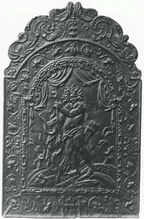
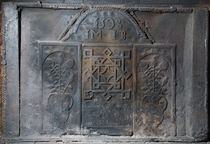
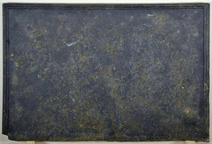
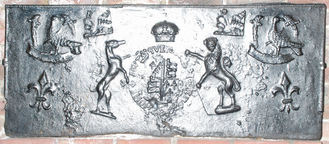
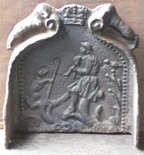
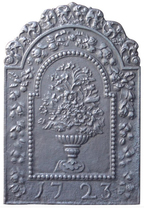
.jpg)
